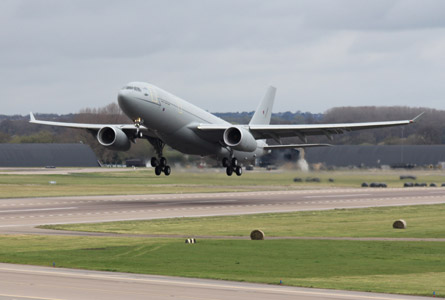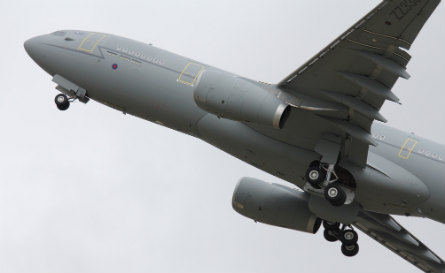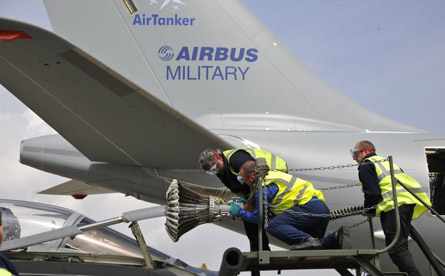A new era of Royal Air Force air transport capability began on 8 April, when a modified Airbus A330 performed the first training flight from its Brize Norton hub in Oxfordshire.
To be introduced via the Future Strategic Tanker Aircraft (FSTA) programme, 14 new "Voyagers" will dramatically transform the RAF's tanker/transport inventory, which today comprises Lockheed TriStars and Vickers VC10s. Critical to sustaining the UK's "air bridge" with Afghanistan and providing air-to-air refuelling (AAR) services to RAF and coalition strike aircraft there, and also during last year's Libya campaign, both legacy types are in urgent need of retirement. FSTA contractor AirTanker Services will be responsible for the delivery, operation and maintenance of the Voyager aircraft during an operational period of at least 24 years. It will also recruit and train some of the system's pilots and engineers under the terms of a private finance initiative deal.
 |
|---|
© AirTanker The modified A330 will soon fly its first military passengers |
"It's a very ambitious programme, both from an industrial and RAF perspective," says AirTanker chief executive Phill Blundell. Although modified for use by the military, each Voyager will offer airliner-style creature comforts, including in-flight entertainment and a minimum 34in seat pitch through its 291-seat, single-class cabin configuration, he notes.
Compared with the RAF's past use of second-hand air transport assets, adapting the A330 will also offer commercial-type dispatch rates. "This aircraft will deliver a step-change in reliability and capability," says James Scott, AirTanker's director of flight operations.
Moving troops and equipment between Brize Norton and Afghanistan will be a major responsibility. The RAF's fleet, which also includes seven Boeing C-17s, moved about 58,000 personnel during the 12-month period to April 2012, says assistant chief of the air staff Air Vice Marshal Baz North. "Voyager represents a complete and long-term service, which will be a huge increase in capability over our current aged fleet," he adds.
The aircraft involved in the first training flight event was the second of two to have been modified at Airbus Military's Getafe site near Madrid. Like half of the UK's eventual fleet, this was modified as a two-point tanker, carrying Cobham 905E hose and drogue refuelling pods beneath its wing.
Aircraft ZZ330's milestone sortie on 8 April was flown by AirTanker-recruited pilots, but with the officer commanding the RAF's 10 Sqn also on board. The first familiarisation flight was swiftly followed by more.
"We've flown every day since," Blundell told Flightglobal on 12 April. Typically, this involved 90min to 2h sector lengths around the UK to support initial training, general handling and to qualify the aircraft's cabin crew.
 |
|---|
© AirTanker |
The first Voyager arrived at Brize Norton on 22 December 2011, and had been expected to begin flying operations in late January. However, the certification approvals process took longer than expected, in part because the modified airliner is the first new type to enter use since the UK's far-reaching Haddon-Cave review. Implemented following the 2006 loss of an RAF British Aerospace Nimrod MR2 XV230 with 14 lives over Afghanistan, this has led to a small number of senior "duty holders" and the new Military Aviation Authority being accountable for aircraft safety.
Release to service approval was granted by the RAF on 4 April, clearing the type to perform air transport and aeromedical evacuation tasks. Air-to-air refuelling clearance will follow later.
One consequence of the introduction delay is that the A330 was required to undergo its first C-check in Manchester from mid-April. Once back at Brize Norton in late April, it will swiftly begin transporting passengers, while at the same time supporting the conversion of the first RAF pilots to fly the type.
AirTanker has a cadre of five civilian instructor pilots available from an eventual minimum of 14 civilian pilots. Its recruits either have experience as training captains on civil A330s, or flew Airbus Military's multi-role tanker/transport (MRTT) version or other tankers while in the armed forces. The next six recruits have completed selection at the RAF College at Cranwell, Lincolnshire and will begin their work at Brize Norton as the Voyager fleet grows. Eventually, the aircraft will be flown by a mix of RAF and AirTanker sponsored reservist pilots.
A new full-mission simulator has just been broken down at Thales' Crawley site in West Sussex, and should be operational by early November in the AirTanker training building. It will join other synthetic and computer-based equipment provided via the FSTA contract.
To commence during May, early passenger flights will be used to transfer personnel to and from locations such as Cyprus and the Middle East, but not yet Afghanistan. The first transatlantic tasking to the USA is likely to come in June or July, says Scott. As during the operational debut, aircraft which are performing air transport tasks only will be flown with their under-wing pods and some camera equipment required to support the AAR mission removed, reducing drag.
With 101 Sqn's aged VC10s to be retired starting from late this year, the available Voyager fleet is required to grow fast. The first two of 12 examples to be modified by Cobham Aviation Services in Bournemouth, Dorset are due to be delivered in late 2012 and early 2013 respectively.
"We should then start to receive another aircraft every three or four months, giving us six or seven by the end of 2013," Scott says. The FSTA service should meet a formal in-service date of mid-2014, when a core fleet of nine AAR-capable aircraft will be in use. But further work must be done before the new type can receive the required clearance to provide operational in-flight refuelling services for combat aircraft and other assets.
 |
|---|
© Qinetiq Fixes to a fuel venting issue which affected trials with a Tornado GR4 will undergo tests |
UK minister for defence equipment and support Peter Luff earlier this year revealed that initial flight tests performed using the other Airbus Military-modified tanker and a Panavia Tornado GR4 had encountered challenges. "During a trials programme, issues emerged on the stability of the hose and fuel leakage," he said.
AirTanker says the hose stability issue has been fixed, but that a fuel "venting" problem arose during about 20% of the wet contacts made with UK fast jet receivers. However, this did not occur when Spanish air force fighters supported certification tests of the same equipment for A330 MRTT launch user the Royal Australian Air Force.
Analysis of the problem has revealed the issue stemmed largely from system response and the closing speed at which test pilots were engaging the fuel hose basket. Airbus Military and Cobham were asked to certificate a design capable of handling contacts made at between 3ft/sec and 10ft/sec, but it was found that in UK trials these were being made at only 1-1.5ft/sec. This resulted in either a poor connection or the hose withdrawing in some instances.
"We've got to do some tuning of the system," says Blundell. Fixes to the basket and AAR system software have already been identified, and fresh flight testing should commence from Qinetiq's Boscombe Down site in Wiltshire from May. The new phase will involve passing fuel to the Tornado GR4 and Eurofighter Typhoon, plus to large receivers such as the Lockheed Martin C-130J tactical transport using the three-point tanker's fuselage refuelling unit.
Source: Flight International
















